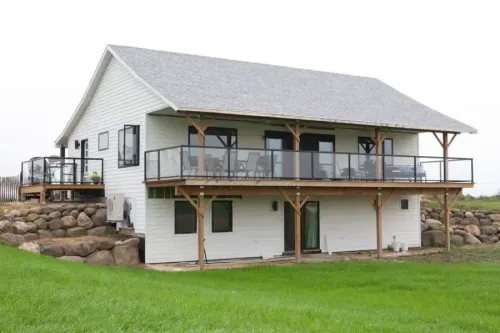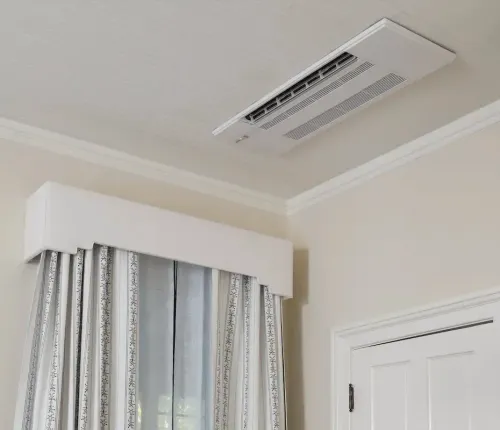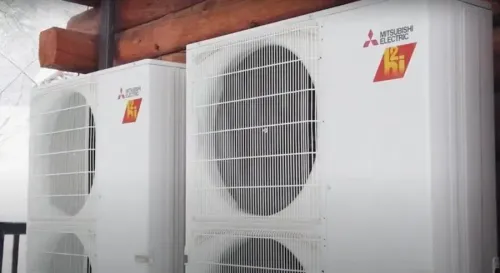Project Location: Cloquet, Minnesota
Completion Date: April 2019
Challenge
a utility company wanted to replace its faulty HVAC system and keep occupants warm with an efficient, electric-powered system in cold wintersSolution
Mitsubishi Electric CITY MULTI® with Hyper-Heating INVERTER® (H2i®) TechnologyResult
A resilient, comfortable office demonstrating the benefits of Variable Refrigerant Flow systems and Strategic Electrification in cold climates
Minnesota Power is a regional utility company serving 145,000 customers in Northeastern Minnesota. Staff pride themselves on promoting energy-efficient technologies and saving customers money. Like many of its customers, Minnesota Power faces efficiency challenges within existing and aging facilities. This led leadership to pursue a high-performance HVAC retrofit in one of its offices.
After seven years of failing compressors, humidity issues and frigid winters, a defective HVAC system in its Cloquet, Minnesota office had left the utility company at its wit’s end. After assessing the needs of the building and its occupants, the sales team from Mitsubishi Electric Trane HVAC US (METUS) specified and designed a CITY MULTI® Variable Refrigerant Flow (VRF) system, finally solving the building’s issues.
Addressing The Issue
The Cloquet office is home to Minnesota Power’s customer-service department and linemen who are in and out of the building several times each day. While only serving about 20 employees at a time, the 5,000-square-foot office space was in need of attention.
“For four summers in a row, we didn’t have air conditioning. We went through winters with only baseboard heat and hot summers with fans running constantly,” expressed Craig Kedrowski, business service advisor, Minnesota Power. “The HVAC units seemed to be ‘fighting’ one another and the vendor was not responsive in helping us with our system’s issues. It prompted us to seek out another solution.”
In 2018, local mechanical contractor, Zach Wehr from Eclipse Inc., who had worked with Minnesota Power’s conservation program, invited Jake Sajevic, account manager, Trane, to tour the office. Their goal: determine the issues with the existing VRF system and offer a solution. “Every time Zach and I did a walkthrough, the system wasn’t working,” said Sajevic. “There were multiple service calls and the summers were always muggy and hot. Sometimes we’d notice the outdoor unit fans were spinning, but you’d hold up your hand to the units and they weren’t rejecting any heat.”
Ultimately, Wehr and Sajevic knew CITY MULTI was the solution Minnesota Power needed and invited Mark Totino, commercial area sales manager, METUS, to visit the property and consult on the system’s design. “Mark and I met with two Minnesota Power staff members and talked through their system’s issues,” said Sajevic. “A big selling point was installing a two-pipe system instead of a three-pipe system. Less piping rules and fewer joints simplify the installation, which can lead to a more successful project.” Right away, Totino also noticed significant errors in the existing installation.
“The manufacturer had done a custom prototype for the system and it basically failed,” explained Totino. “They had added a boiler on to the air-cooled condensing unit to keep it running in the wintertime and it was not functional. There were record-breaking low temperatures in our region this winter. The only way the building stayed warm was by using their electric baseboard auxiliary heat.”
A Turnkey Manufacturer Solution
Once a design was established, the group presented their plan to Minnesota Power as a turnkey manufacturer project. METUS took on equipment distribution and Eclipse was contracted for the labor. Kedrowski and his team were thrilled. “A big issue we had with the previous vendor’s system is that they didn’t take into account the makeup air units or building controls. The METUS team and Eclipse took everything into account with their strategy,” said Kedrowski. “With the chance to go with METUS, we jumped at the opportunity.”
The design includes an R2-Series Heat Recovery System with Hyper-Heating INVERTER® (H2i®) technology as well as two PKFY Wall-Mounted Indoor Units, 10 PEFY Horizontal-Ducted Indoor Units and three Lossnay® Energy Recovery Ventilators (ERVs) to bring in fresh, outside air. 12 Smart MEs and one Ae-200A Centralized Controller were specified for system management. Each tie in to Minnesota’s Power’s building automation system at their Duluth headquarters location, streamlining efficiency and comfort control.
Another benefit: the VRF system doubles as a display of energy-efficient performance for the company’s current and future customers.
Electrification IN Cold Climates
For Minnesota Power, having an effective, electric-powered VRF system does more than solve comfort issues. “Minnesota is one of the frontrunner states in the country to strive towards strategic, or beneficial electrification,” explained Totino. This concept involves moving from fossil fuel reliance to the electric grid which reduces carbon emissions and cuts consumer costs.
“Because we recommend this equipment in our conservation program, we were interested in having a showcase where we present simultaneous heating and cooling,” said Kedrowski. “Beneficial electrification is something that’s really coming along. Our town’s big university and city buildings are looking for options to increase sustainability and move away from fossil fuel use.” In the Cloquet office’s conference room, two indoor units each connect to an individual thermostat that lights up either blue or red for cooling or heating, respectively. “Side-by-side, they’ll be able to show and explain the concept of heat recovery. This building is a testament to their support of electrification,” noted Totino.
However, Minnesota winters pose a big challenge with electrification: extreme cold. “There are some unique hurdles the farther north you go,” said Sajevic. “Our design’s low-ambient temperature is -20° F and it can get even colder. I’ve talked with engineers all over the region and they think VRF is a great technology but only a few are comfortable specifying it because of the low-ambient conditions we face.” For Sajevic, combining supplemental heat with VRF technology is a win-win; customers get clean, energy-efficient energy, with back-up heating for freezing winters.
“For many developers and engineers, their gut reaction is to explain why electric heat is super expensive to run. What I explain to them is that when paired with Mitsubishi Electric’s H2i units, the auxiliary heat will almost never run,” said Sajevic. “For this project, we’re going to continue to submeter the electric heat going into next winter and we’ve interlocked the controls system with our Cn-24 accessory, which enables supplemental heat sources. We’ll be able to verify how often the supplemental heat actually runs and under what outdoor conditions it is enabled.”
Wehr agreed, especially as a commercial engineer in the region. “First and foremost, the technology has come a long way, especially in terms of payback, life expectancy, rate of return on investment, and performance. Though I can understand the apprehension of some based on past technology,” said Wehr. “That said, the system we installed at Minnesota Power will kick off at -25° F below zero and switch to supplemental heat. I have the highest confidence in the equipment. I’ve had it in my building since 2008 with no issues.”
Future Focused
Installation took place in April 2019 and the system has only received positive feedback, especially in regard to the simultaneous heating and cooling. “I’m glad we finally got this rectified,” said Kedrowski. “Our coworkers are loving it. We have some people that want their room 80° F even in the summer and then some want it 65° F. The Mitsubishi Electric system allows them to do that.”
Even more, the system allows Minnesota Power staff to continue clean energy efforts and educate customers. “Public utilities like Minnesota Power are making the investment and doing the research for the betterment of the communities they serve. Projects like this are especially important for engineers and building owners to see because they’re the ones with the funds to take electrification mainstream,” said Wehr.
Project Team
- HVAC Design Support: Mitsubishi Electric Trane HVAC US (METUS)
- Mechanical Contractor: Eclipse, inc., Cloquet, Minnesota
Mitsubishi Electric Equipment Installed
- (1) CITY MULTI® R2-Series Hyper-Heating INVERTER® (H2i®) Units
- (10) PEFY-P Ceiling-Concealed Ducted Units
- (2) Pfky Wall-Mounted Indoor Units
- (3) Lossnay® ERVs
- (1) Ae-200 Centralized Controller
- (12) Smart ME Controllers









